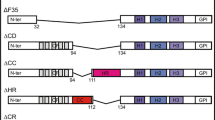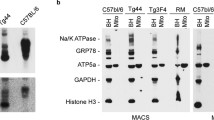Abstract
Transmissible Spongiform Encephalopathies are fatal neurodegenerative disorders of humans and animals that are familial, sporadic, and infectious in nature. Familial disorders of humans include Gerstmann-Straussler-Scheinker disease (GSS), familial Creutzfeldt-Jakob disease (CJD), and fatal familial insomnia, and result from point mutations in the prion protein gene. Although neurotoxicity in familial cases is believed to result from a spontaneous change in conformation of mutant prion protein (PrP) to the pathogenic PrP-scrapie (PrPSc) form, emerging evidence indicates otherwise. We have investigated the processing and metabolism of mutant PrP D202N (PrP202N) in cell models to elucidate possible mechanisms of cytotoxicity. In this report, we demonstrate that PrP202N expressed in human neuroblastoma cells fails to achieve a mature conformation following synthesis and accumulates in the endoplasmic reticulum as ‘curly’ aggregates. In addition, PrP202N cells show increased sensitivity to free radicals, indicating that neuronal susceptibility to oxidative damage may account for the neurotoxicity observed in cases of GSS resulting from PrP D202N mutation.
Similar content being viewed by others
References
Aguzzi, A., & Polymendiou, M. (2004). Mammalian prion biology: One century of evolving concepts. Cell, 116, 313–327.
Brown, D. R., Nicholas, R. S., & Canevari, L. (2002). Lack of prion protein expression results in a neuronal phenotype sensitive to stress. Journal of Neuroscience Research, 67, 211–224.
Brown, D. R., Schulz-Schaeffer, W. J., Schmidt, B., & Kretzschmar, H. A. (1997). Prion protein-deficient cells show altered response to oxidative stress due to decreased SOD-1 activity. Experimental Neurology, 146, 104–112.
Capellari, S., Parchi, P., Russo, C. M., Sanford, J., Sy, M.-S., Gambetti, P., et al. (2000). Effect of the E200K mutation on prion protein metabolism. American Journal of Pathology, 157, 613–622.
Gu, Y., & Singh, N. (2004). Doxycycline and protein folding agents rescue the abnormal phenotype of CJD H187R in a cell model. Brain Research: Molecular Brain Research, 123, 37–44.
Harris, D. A., & True, H. L. (2006). New insights into prion structure and toxicity. Neuron, 50, 353–357.
Hetz, C., Russelakis-Carneiro, M., Walchli, S., Carboni, S., Vial-Knecht, E., Maundrell, K., et al. (2005). The disulfide isomerase Grp58 is a protective factor against prion neurotoxicity. Journal of Neuroscience, 25, 2793–2802.
Lasmezas, C. I., Deslys, J. P., Robain, O., Jaegly, A., Beringue, V., Peyrin, J. M., et al. (1997). Transmission of the BSE agent to mice in the absence of detectable abnormal prion protein. Science, 275, 402–405.
Ma, J., & Lindquist, S. (2001). Wild-type PrP and a mutant associated with prion disease are subject to retrograde transport and proteasome degradation. Proceedings of the National Academy of Sciences of the United States of America, 98, 14955–14960.
Ma, J., Wollmann, R., & Lindquist, S. (2002). Neurotoxicity and neurodegeneration when PrP accumulates in the cytosol. Science, 298, 1781–1785.
Mishra, R. S., Gu, Y., Bose, S., Verghese, S., Kalepu, S., Singh, N., et al. (2002). Cell surface accumulation of a truncated transmembrane prion protein in Gerstmann-Straussler-Scheinker disease P102L. Journal of Biological Chemistry, 277, 24554–24561.
Prusiner, S. B. (1998). Prions. Proceedings of the National Academy of Sciences of the United States of America, 95, 3363–3383.
Singh, N., Gu, Y., Bose, S., Basu, S., Luo, X., Mishra, R., et al. (2005). Processing and mis-processing of the prion protein: Insights into the pathogenesis of familial prion disorders. In D. Brown (Ed.), Neurodegeneration and prion disease (pp. 299–318). New York, NY: Life Sciences, Springer.
Singh, N., Zanusso, G., Chen, S. G., Fujioka, H., Richardson, S., Gambetti, P., et al. (1997). Prion protein aggregation reverted by low temperature in transfected cells carrying a prion protein gene mutation. Journal of Biological Chemistry, 272, 28461–28470.
White, A. R., Collins, S. J., Maher, F., Jobling, M. F., Stewart, L. R., Thyer, J. M., et al. (1999). Prion protein-deficient neurons reveal lower glutathione reductase activity and increased susceptibility to hydrogen peroxide toxicity. American Journal of Pathology, 155, 1723–1730.
Author information
Authors and Affiliations
Corresponding authors
Additional information
Yaping Gu and Susamma Verghese contributed equally.
Rights and permissions
About this article
Cite this article
Gu, Y., Verghese, S., Bose, S. et al. Mutant prion protein D202N associated with familial prion disease is retained in the endoplasmic reticulum and forms ‘curly’ intracellular aggregates. J Mol Neurosci 32, 90–96 (2007). https://doi.org/10.1007/s12031-007-0023-6
Received:
Accepted:
Published:
Issue Date:
DOI: https://doi.org/10.1007/s12031-007-0023-6




